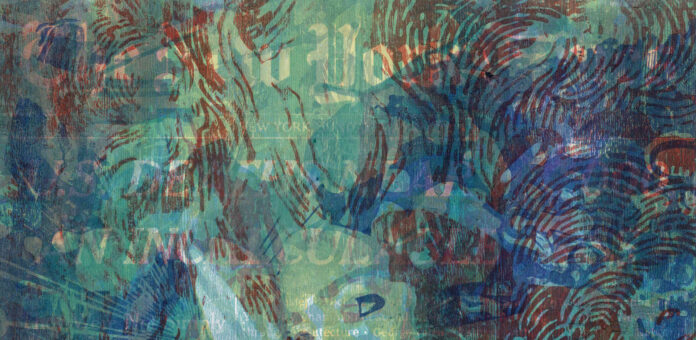At the centre of the showcase exhibition Zorawar Sidhu and Rob Swainston – Plague and Protest are two colour woodcuts by New York based artists Zorawar Sidhu (* 1985) and Rob Swainston (* 1970) from their 18-part series Doomscrolling (2021). These works are being displayed for the first time at the Kupferstichkabinett (Museum of Prints and Drawings). In the series, Sidhu and Swainston deal with significant events that occurred in the United States between 24 May 2020 and 6 January 2021: the spread of the Covid-19 pandemic, the death of George Perry Floyd, the formation of Black Lives Matter and the insurrection in front of and inside the United States Capitol building in Washington, DC. With their woodcuts, Sidhu and Swainston created vividly coloured depictions of early 21st-century historical events.
For the series, Swainston and Sidhu may have chosen the oldest printmaking medium, the woodcut, yet their images feel no less contemporary. Material, form and history come together in a unique way in Doomscrolling. Its woodcuts reflect on protest and insurrection, pandemic and isolation, and the dissemination of news through the media, whether digital or analogue, and its consumption, which informs but at the same time creates new dependencies and illnesses. The term doomscrolling refers to the phenomenon of excessive consumption of primarily negative and frightening news, an activity whose harmful effects can include pathogenic psychophysiological reactions and compulsive addictive behaviour.
Wood as a Repository of History
For their printing blocks, Sidhu and Swainston used plywood that had been installed to protect the façade of the Whitney Museum of Art in New York during the riots following the murder of African American George Perry Floyd (1973–2020) by a White police officer in Minneapolis in the US state of Minnesota on 25 May 2020. Rob Swainston described his impressions of New York: “Suddenly, the sheets of plywood went up, and in those wooden panels covering Manhattan, I recognized the potential of inscribing them with the events of 2020.”
Transepochal Images of Plague and Protest
In the Doomscrolling woodcuts, Swainston and Sidhu merged images they had made in 2020 with their cameras in New York or researched on the Internet with print imagery from past centuries. These include graphic works by Albrecht Dürer, Romeyn de Hooghe and Käthe Kollwitz. This transepochal approach is pursued further in the Kupferstichkabinett presentation. For instance, in addition to the two contemporary woodcuts, 16 prints and drawings from the 16th to 20th centuries deal with subjects of pandemics and insurrection. These include the copperplate engraving Il Morbetto (The Plague, c.1515–16) by Marcantonio Raimondi, the etching Die Pest (The Plague, 1903) by Max Klinger, the lithograph The Barricade (1871) by Edouard Manet, the etching Aufruhr (The Riot, 1899) by Käthe Kollwitz, and the pen and ink drawing Streikversammlung der Bergleute in Charleroi (Miners’ Strike Meeting in Charleroi, 1912) by Sella Hasse.
The artists featured in the exhibition are Jean Baron (after Nicolas Poussin), Honoré Daumier, Käthe Kollwitz, Sella Hasse, Max Klinger, Jan Luyken, Georg Mack the Older, Edouard Manet, the Master of the Miracles of Mariazell, Marcantonio Raimondi (after Raphael), Zorawar Sidhu and Rob Swainston.
Zorawar Sidhu and Rob Swainston – Plague and Protest is curated by Jenny Graser, curator for contemporary art at the Kupferstichkabinett.
A special exhibition by the Kupferstichkabinett in the Gemäldegalerie – Staatliche Museen zu Berlin
Source : Museen zu Berlin













